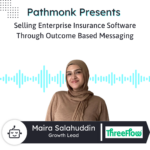SaaS Company
Introduction
Michael McCarthy is the founder and CEO of Inkit which is a software that helps to create and automate sending direct mail to win leads offline. Inkit’s SaaS solution enables companies to communicate with their customers using printed, personalized mail. Their integrations with CRMs enable companies to send direct mail faster, more affordably, and more accurately than ever.
Michael has a background of working with investment banking. In today’s episode, we heard a lot of interesting about combining offline marketing with online marketing & lead generation and bring back the old-school way of sending out direct mail.
In this episode Michael also shared his way how they created Inkit’s brand and how they came up with the vision for it. Check it out…
See how to optimize your offline leads outreach…
Pathmonk: How would this different types of users that you describe, how would they actually end up finding you? Could you describe a typical user journey that they go through in order to get started?
Michael McCarthy: A lot of them find us through search, just like your product. Users will come across as either through our blog or at a trade conference or an event. Much of our traffic is actually drive through our form fields on our website. We again have people that hit our website and our hope is to get them to convert into a demo and then we take it from there from a sales side.
Pathmonk: So you mentioned the website there. What rule would you say does the website and it’s key metrics play in your system?
Michael McCarthy: The website is a very big piece of the overall system. The website houses both the blog, it also tells the brand’s story about our product and who we are as a brand and what we’re striving to be. It also provides information and details on the services that we offer. It’s a very big component. Of course our KPI is first and foremost driving people to enter their information and then essentially hit that submit button.
Pathmonk: I was so curious what types of metrics do you actually care about on the website? Because there’s tons of metrics you could look at. What are the ones that you drive your decisions by?
Michael McCarthy: We constantly are monitoring our page views.We’re looking to make sure that our traffic is going up into the right every month. Meaning we want to grow eyeballs on our site from both an awareness as well as just a traffic perspective. Ultimately that traffic is meaningless if it’s not converting. At the end of the day, the short answer is the one metric that really matters the most is the demo metric. Now we also do measure sub metrics on the demo side, such as, what those quality of leads are and we start to tear it out even further because we know that some channels have higher quality leads than others.
Pathmonk: I’m curious if you have, maybe a war story or a learning to share on how you were trying to improve this conversion metric on the demos. Anything you’ve been trying, anything you learned throughout the way that helped you to increase those?
Michael McCarthy: Yeah, so one of the war stories we’ve learned is number one, always test your demo page.We had a period of time when were first getting going where our demo page was broken for about three days and we now know to always test the demo page before you put it live. So that’s our first recommendation. Our second recommendation is we actually are very interested in starting to enrich our demo information. Meaning if a new demo comes in through our form field, we are working on this as a Q1 2020 initiative, but basically taking that demo submission and then enriching that person’s email name, additional data points so that we can already start to filter that lead as a priority lead and basically lead score them and assign those to the proper reps and teams.
Pathmonk: What types of information you think would be, if you zoom forward to the end of this project, what types of information would you like to see surrounding the leads?
Michael McCarthy: We’d like to see things like Alexa rank. We’d like to see things like their employee count. We’d like to see things like their location cause that helps us route to the proper teams. We also would like to see things like their intended volume or even their sector because we know that some sectors send have different needs than other sectors. There’s quite a few different data points that we’re interested in gaining from that lead form.
Pathmonk: It sounds really cool. It seems like the conversion rates is a relative important metric for you guys. Thanks a lot for sharing the story on how you were trying to get that up and running. Any more challenges you faced or learnings you got by improving the conversion rate? Anything else you could think about. As far as how to optimize the conversion rate personally?
Michael McCarthy: We were very big on the idea of brand. One of our big initiatives is streamlining our brand and really telling this brand story because ultimately people buy from brands that they love and there’s a reason people buy or still buy from Adidas and recognize the three stripes and we’ll choose Adidas over a Chinese, Ali Baba knockoff and so one of the big things that we’re very big on is building this, this really powerful brand and ethos and one of the leaders in that space I believe is a company called the sauna and when people think of a sauna they think of this really fun, this really playful brand and Asana is able to infuse things like unicorns and rainbows and cats and all of these very fun, playful things and we all ultimately want users to have that same type of experience with our brand and streamlining that message from both the application to the marketing side is a huge initiative and priority of ours that we believe will ultimately lead to more conversions as well as stronger conversions and brand recognition and recall rates.
(…)











